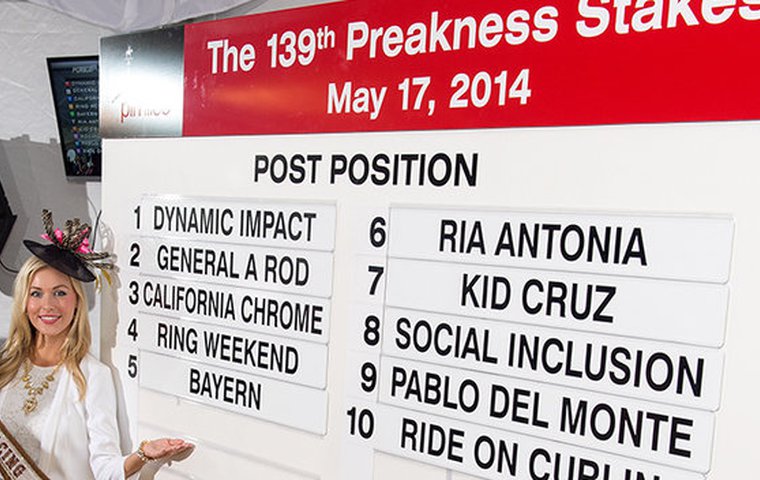
Racing analyst Nick Tammaro examines the records of Derby runners and “new shooters” in the Preakness Stakes and finds that recent history has seldom favored a fresh horse.
Nine rivals will bid to knock California Chrome from his rightful perch atop the ranks of 3-year-old racehorses in Saturday’s Preakness Stakes at Pimlico Race Course. Two of those rivals are horses whom he defeated with great ease in the Kentucky Derby a fortnight ago. The balance of the field, dubbed by most analysts as “new shooters” will bid to break into the Triple Crown scene and upset the heavy favorite. However, racing history has not been kind to these types of horses, especially when you analyze the most recent runnings of the Preakness Stakes.
The inactivity of the modern Thoroughbred is a well-worn topic in racing circles. On average, the very best racehorses in North America today make roughly 60 percent of the starts their counterparts did a half-century ago. The impetus to give horses ample time between starts has drastically affected the composition of the fields in the three races that comprise the Triple Crown. No race has been more affected than the Preakness, which is still run just 14 days after the Kentucky Derby. Nowadays, it is almost unheard of for a horse to race in a GI event off of less than 28 days’ rest.
Despite this trend toward fewer starts and more time between races, the Preakness Stakes has been largely dominated by horses who also raced in the Kentucky Derby. In each of the last two years, the 1-2-3 finishers were horses who were returning on short rest after the Kentucky Derby. In each of the last five Preaknesses, two of the three horses who finished in the trifecta had run in the Kentucky Derby. Only twice in the last 13 runnings did the winner enter off of any race other than the Kentucky Derby.
The two exceptions were eventual Eclipse Award winner Bernardini (2006) and Horse of the Year Rachel Alexandra (2009). However, both Bernardini and Rachel Alexandra had run within the three weeks leading up to the Preakness. Bernardini’s breakthrough win in the Withers Stakes at Aqueduct Racetrack occurred on the final weekend of April, just 21 days before his tour de force in Baltimore. Rachel Alexandra had famously demolished her competition in the Kentucky Oaks just 15 days before defeating males in the Preakness. Since 1980, only two horses have won the Preakness after being off for more than 21 days - Codex (1980) and Red Bullet (2000).
This year’s Preakness features five runners whose recent activity is in direct contrast with the above detailed trends. Other than the three Derby participants (California Chrome, Ride on Curlin, General a Rod), Ria Antonia raced in the Kentucky Oaks just 15 days ago, and Bayern missed narrowly in the Derby Trial 21 days ago. Social Inclusion, Dynamic Impact, Pablo del Monte, Kid Cruz, and Ring Weekend, none of whom has started more recently than 28 days ago, will be the candidates to join Codex and Red Bullet and buck the trend.
Not only have non-Kentucky Derby participants encountered trouble winning the Preakness, they have had limited success even landing minor placings in recent years. In the last 13 runnings of the Preakness, a total of 76 starters entered without having run in the Kentucky Derby. Among that group, only one was victorious (Red Bullet), and a grand total of 10 finished in the money. The Preakness participants who entered having not raced in the 21 days prior have also struggled. There have been 71 starters in the last 13 years who fit that profile, and they are a combined 0-71 on the win end with nine runners who finished in the money. A simple $2 “across the board” wager on these horses would have forced you to layout $426. In return, you would have received a total of $150, a loss of 65 cents for every dollar invested. Looking at it from the other side, a total of 66 starters in the last 13 Preaknesses had also run in the Kentucky Derby. They have won 11 of the 13 editions of the race, and have occupied top three slots 28 of 66 times (42 percent).
The recent changes made in the process used to determine the Kentucky Derby field were designed to ensure the best 3-year-olds available would contest the race. Even before that, qualification based on graded stakes earnings all but guaranteed the most successful 3-year-olds would have a spot in the Kentucky Derby starting gate. Then, and now, the more undeserving sophomores who didn’t make the Derby quite frequently become the “new shooters” in the Preakness. Of this year’s six Preakness starters who did not run in the Kentucky Derby, two are coming off of wins, three are exiting efforts where they wound up beaten as the favorite, and one most recently ran the worst race of her 2014 campaign. The 2014 “new shooters” group very much fits the profile of horses that have struggled in the Preakness and contributed to a growing powerful trend.
California Chrome will bid to become the sixth horse in the last 13 years to win the Preakness after also taking the Kentucky Derby. His experience and the foundation that trainer Art Sherman built into him has served him well. Sherman is hardly a stranger to running horses back quickly, given his background as a conditioner of claiming horses. In fact, he has 21 starters during the last five years who were returning in 1-14 days. His competition looks to be subpar, given that he handled the other two Kentucky Derby alums with great ease in Louisville. History is also working squarely against the seven non-Derby participants.


